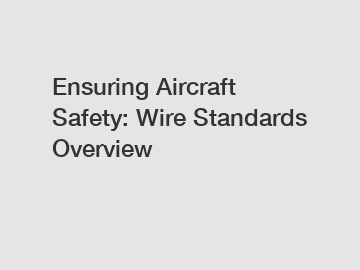Ensuring Aircraft Safety: Wire Standards Overview
Ensuring Aircraft Safety: Wire Standards Overview.
Aircraft safety is of utmost importance in the aviation industry, and one critical aspect that contributes to achieving this is the compliance with wire standards. Wire standards outline the requirements and specifications for wiring systems in aircraft, including materials, construction, installation, and maintenance. By adhering to these standards, manufacturers, operators, and maintenance personnel can ensure that the wiring systems on aircraft meet the necessary quality and performance criteria to guarantee safe and reliable operation.
The origins of wire standards in aviation can be traced back to the early days of flight when rudimentary wiring systems were prone to failures and malfunctions. As aircraft technology evolved and became more complex, the need for standardized practices and specifications for wiring systems became apparent. The establishment of wire standards by regulatory bodies such as the Federal Aviation Administration (FAA) and the European Aviation Safety Agency (EASA) helped to streamline the design, manufacturing, and maintenance processes for aircraft wiring systems.

The process of ensuring compliance with wire standards involves rigorous testing, inspection, and certification procedures. Manufacturers must demonstrate that their wiring systems meet the specified requirements through various tests, including electrical conductivity, insulation resistance, and mechanical strength. Additionally, strict quality control measures are implemented throughout the production process to eliminate any defects or discrepancies that could compromise the safety and reliability of the wiring systems.
The significance of wire standards in aviation cannot be overstated, as they play a crucial role in preventing electrical failures and fires that could jeopardize the safety of passengers and crew. By adhering to established wire standards, aircraft manufacturers can mitigate the risks associated with wiring system failures and ensure that their products meet the highest safety standards. For operators and maintenance personnel, compliance with wire standards simplifies the inspection, repair, and replacement processes for wiring systems, reducing the likelihood of errors and enhancing overall safety.
In conclusion, wire standards are essential for ensuring aircraft safety and reliability. By establishing clear requirements and specifications for wiring systems, regulatory bodies and industry stakeholders can uphold the highest safety standards and minimize the risks associated with electrical failures. Compliance with wire standards benefits manufacturers, operators, and maintenance personnel alike, providing a framework for safe and efficient operation in the aviation industry. Ultimately, adherence to wire standards is a fundamental aspect of ensuring the safety and security of aircraft and their occupants.
For more information, please visit Incoloy Wire Mesh, Rare Metal Wire Mesh, Titanium Woven Wire Mesh.

Comments
0